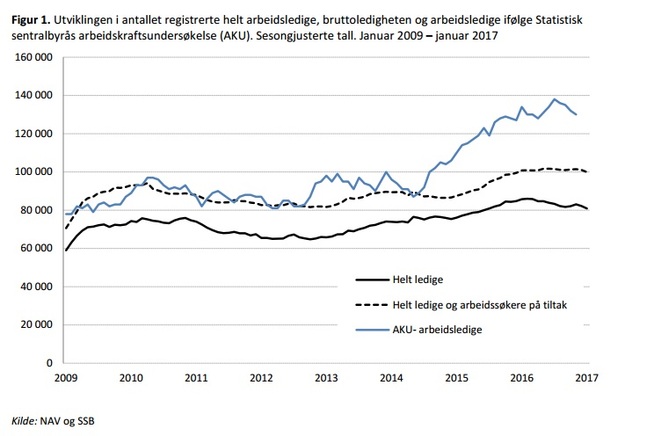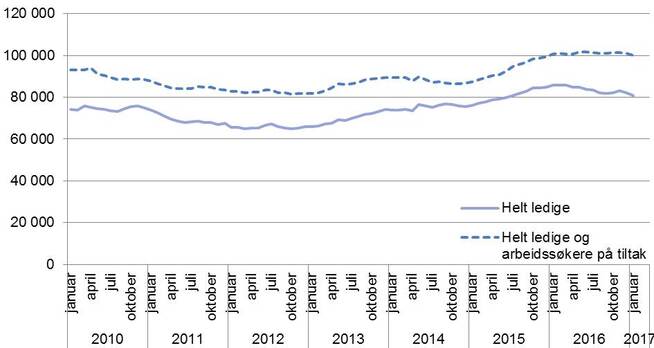Labour and welfare administration Nav put Friday forward arbeidsledighetstall.
They show that the unemployment rate rose to 3.2 per cent in January, from 2.8 per cent in December.
and yet, There is no drama in the climb. Unemployment rate rises as a rule in January, due to seasonal fluctuations.
Adjusted for these fluctuations falling unemployment rate with a 1,200 people from December to January, ” says Nav.
the Unemployment rate fell in January. It is caused by, among other things, that the number of new which was free to the NAV was at its lowest level since December 2014, says the ministry of labour and velferdsdirektør Sigrun Vågeng.
The adjusted unemployment rate is down by about 5,000 persons from one year ago, when the unemployment rate was at 3.4 per cent, according to Nav.
Better than expected
the Numbers are in line with estimates from DNB Markets. The bank had in advance expected an unemployment rate of 3.2 per cent, since the unemployment rate would normally use to rise in January.
– unemployment rate was better than expected, with a fairly large decline in the number of available, printer, DNB Markets-analyst Jeanette Power Ebb in a comment.
– the Decline in both the LFS unemployment rate and registered ledighetstallene the last time points in the direction of that most of the increase in the unemployment rate is behind us, she writes.
Nordea Markets had expected unchanged unemployment rate in January.
In December had Nav registered 78.600 unemployed, which corresponds to 2.8 percent of the workforce. In January was the number of registered unemployed 88.200. One year earlier was 93.300 registered as unemployed.
Fluctuations in the labour market is, however, less when one adjusts for normal variations. The seasonally adjusted unemployment rate was at 80.914 people in January, against 82.151 people in December and 85.701 people one year ago, according to Nav.

the NUMBERS of his poem: There is still a certain distance from the number of registered unemployed with Nav to the figures from Statistics Norway’s labour force survey, which includes people who are on the jobbjakt without registering with Nav.
do not Count all
nav’s figures for unemployment are lower than the figures from Statistics Norway, which also includes people who are looking for work without having registered with Nav.
the Unemployment rate was at 4.7 per cent in november, according to the labour force survey *(LFS) from STATISTICS norway.
– Although the difference has become a little less, is the LFS unemployment rate is still a good deal higher than the registered unemployment rate, with flat to declining employment in the last year. It indicates that the labour market may be somewhat weaker than the registered ledighetstallene alone indicates, ” says Ebb.
the population was in January 108.500 people who are in action or are totally unemployed, according to the Nav. There are 800 fewer than in January of last year, and equivalent to 3.9 percent of the labour force, which is the same as in the last year, according to the agency.
on Friday at 12 responding labor minister Anniken Hauglie (H) questions about the unemployment rate at VG Nett.
You can send your questions to the Hauglie here
the Workforce may decrease
Normally, the labour force in Norway will be less when there is a recession, because more then choose to take education or be at home in a period of time, according to DNB Markets.
the Bank has estimated that the unemployment rate will rise going forward.
Measured by statistics norway’s labour force survey, unemployment will probably be at 4.9 per cent this year and 5 percent next year, think DNB Markets.
– Norges Bank expects a slight rise in the seasonally adjusted unemployment rate in the first quarter and today’s figures are a bit more positive. It should mean little for the interest rate decision in march, where we nevertheless believe on the unchanged key policy rate, ” says Ebb.

RISING UNEMPLOYMENT rate: The past few years, unemployment has risen somewhat, according to the Nav. This table shows the Register ledighetstall in the period between 2009 and 2017.
No comments:
Post a Comment